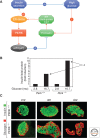Protein-folding homeostasis in the endoplasmic reticulum and nutritional regulation
- PMID: 23209157
- PMCID: PMC3504434
- DOI: 10.1101/cshperspect.a013177
Protein-folding homeostasis in the endoplasmic reticulum and nutritional regulation
Abstract
The flux of newly synthesized proteins entering the endoplasmic reticulum (ER) is under negative regulation by the ER-localized PKR-like ER kinase (PERK). PERK is activated by unfolded protein stress in the ER lumen and inhibits new protein synthesis by the phosphorylation of translation initiation factor eIF2α. This homeostatic mechanism, shared by all animal cells, has proven to be especially important to the well-being of professional secretory cells, notably the endocrine pancreas. PERK, its downstream effectors, and the allied branches of the unfolded protein response intersect broadly with signaling pathways that regulate nutrient assimilation, and ER stress and the response to it have been implicated in the development of the metabolic syndrome accompanying obesity in mammals. Here we review our current understanding of the cell biology underlying these relationships.
Figures



References
-
- Birkenfeld AL, Lee HY, Majumdar S, Jurczak MJ, Camporez JP, Jornayvaz FR, Frederick DW, Guigni B, Kahn M, Zhang D, et al. 2011. Influence of the hepatic eukaryotic initiation factor 2α (eIF2α) endoplasmic reticulum (ER) stress response pathway on insulin-mediated ER stress and hepatic and peripheral glucose metabolism. J Biol Chem 286: 36163–36170 - PMC - PubMed
-
- Boyce M, Bryant KF, Jousse C, Long K, Harding HP, Scheuner D, Kaufman RJ, Ma D, Coen D, Ron D, et al. 2005. A selective inhibitor of eIF2a dephosphorylation protects cells from ER stress. Science 307: 935–939 - PubMed
Publication types
MeSH terms
Substances
Grants and funding
LinkOut - more resources
Full Text Sources
